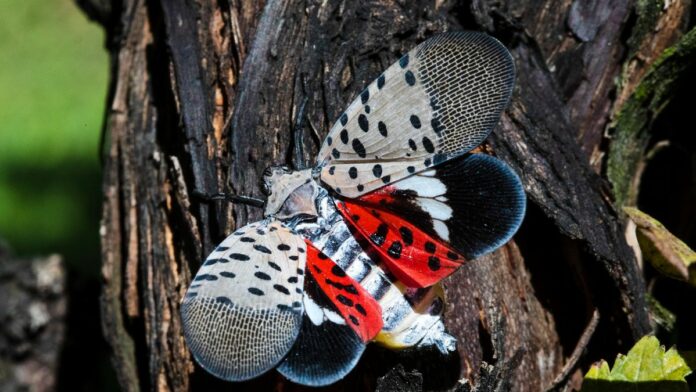Last year’s Brood X cicada invasion ended up sparing most of the tri-state area (though beware Brood II’s arrival, b’ezras Hashem, in 2030). But we tri-staters, like many people to the south and west, have become acquainted of late with a new winged visitor, an import from Asia: spotted lanternflies.
Technically, the lanternfly is not a fly, or a moth, which it resembles. It belongs to the planthopper family, which you more likely know as the infraorder Fulgoromorpha (in, of course, the suborder Auchenorrhyncha).
However you classify it, though, it is a striking insect. As adults, lanternflies have a black head and gray-brown forewings adorned with black spots. And their hind wings—only partially visible when the bugs are at rest—are a bright, actually quite beautiful, red.
They don’t bite or sting. But they do eat crops and damage trees, eating their sap and excreting a substance that attracts mold, leaving trees more susceptible to disease and death.
Which is why agricultural officials across multiple states have asked citizens to kill the bugs on sight. “Stomp It Out,” says the New Jersey Department of Agriculture,“Kill it! Squash it, smash it … just get rid of it,” is the Pennsylvania Department of Agriculture’s plea.
The bugs aren’t great fliers, but they can hitch rides on cars, and lay egg masses of up to 50 eggs apiece. So the multi-state trepidation isn’t without warrant.
Personally, I have a hard time killing living things, even creepy crawlers. (Please don’t bring up those ants and my magnifying glass. I was only seven and motivated entirely by scientific curiosity.) When a stinkbug or spider or bee invades our home, it is carefully caught and politely escorted to the outdoors. (Okay, mosquitos are an exception; they all receive the death penalty.)
Early on, people generally thought lanternflies lacked natural predators in our part of the world. But birdwatchers began to report cases of their subjects dining on the little invaders. The heartiest eaters of the bugs seem to be cardinals, jays and chickens.
Interestingly, though, research led by PhD candidate Anne Johnson at Pennsylvania State University seems to yield the fact that birds are reluctant to eat lanternflies that have feasted on a common tree known as a “tree of heaven,” which, like the lanternfly, came to us from the Far East. It is the tree referred to in the title of the 1943 book A Tree Grows in Brooklyn. And, in fact it does, not only in Brooklyn but across most of the country.
Consuming the sap of the tree of heaven, Ms. Johnson surmises, gives the bugs a bitter or otherwise unpleasant taste (can’t confirm; my scientific curiosity has its limits).
But lanternflies that have been deprived of that tree as a food source seem to be eaten with relish (well, not the side dish, but you know what I mean) by birds.
Were it possible to get rid of the invasive tree, we might, with the help of feathered friends, come to be rid of the invasive bug.
Alas, though, the tree of heaven, as noted, is ubiquitous, and so the idea, intriguing though it is, does not offer a practical solution.
Neither, though, does stomping on individual bugs that cross our paths. Unless hordes of citizens in affected states can be convinced to form posses to actively seek out and stomp on the little guys, there are just too many of them (the little guys, not the citizens).
Another strategy that has been broached is based on the fact that, in its native China, the lanternfly has a natural enemy that keeps it at bay: Dryinus browni. No, not a Girl Scout, but rather a tiny wasp that lays its eggs inside baby lanternflies. The eggs hatch into larvae that feed on the nymphs and kill them. If we brought some brownis over here…
Count me out, though, as a supporter of importing yet another biological entity from China. Not a great idea. The tree of heaven, then the lanternfly, then… COVID.
Maybe a stomp-a-thon really is the
way to go.





















